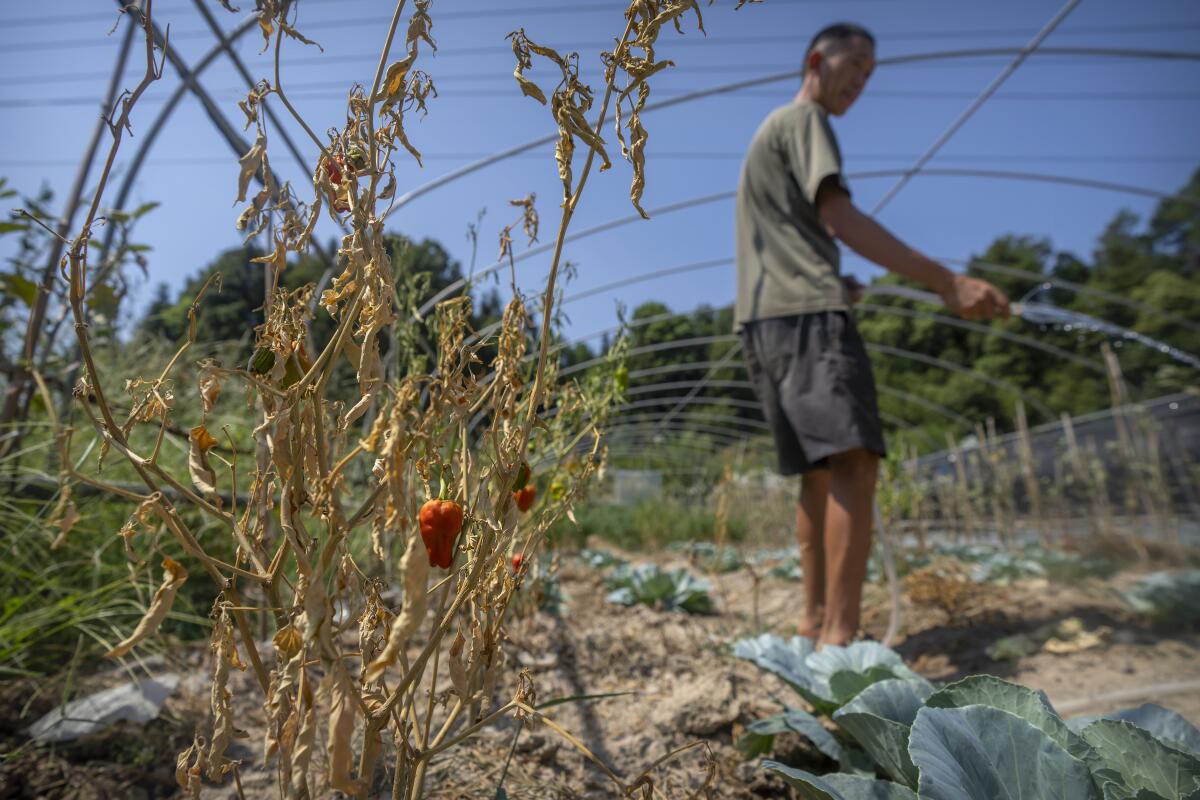Newsletter: China is suffering the worst heat wave ever recorded. Did you hear about it?

Good morning. I’m Paul Thornton, and it is Saturday, Aug. 27, 2022. Let’s look back at the week in Opinion.
The summer so far in Los Angeles may feel mild, but those of us who consume a steady diet of climate news are sweating over a disaster unfolding halfway across the world. You probably haven’t read much about this in American media, but vast portions of China are drying up amid a catastrophic heat wave lasting longer than two months — not a few days or even the two or three weeks that would make a heat emergency in California historic, but a whole summer.
The extended heat wave has upended daily life in much of China, home to 1.4 billion people. Hydropower generated by dams is at a critical shortage because the rivers that spin turbines are drying up (portions of the mighty Yangtze River, the world’s third-largest, have been reduced to an L.A. River-like trickle). In the Sichuan province of China, there are reports of residents fleeing into underground bunkers to escape the oppressive heat at the surface. These are some of the worst-case scenarios, once thought to be decades into the future absent meaningful emissions cuts, that we may soon face in places like Lake Mead and parts of the United States that have seen their highest overnight low temperatures this summer.
What does this have to do with our Opinion content? I’d argue a lot, because the ongoing climate emergency colors almost everything that happens in Los Angeles. We live in a metro area that makes grand statements about global warming and passes laws meant to reduce our emissions dramatically over time, but we remain a structurally car-dependent cityscape where life expectancies are shortened because of air pollution and hundreds of people annually are killed in traffic. Hopefully, that’s beginning to change, as the city of Los Angeles decided to make a small portion of Griffith Park Drive permanently off-limits to drivers, prompting the Times Editorial Board to ask readers for their ideas on where the next car-free street should be. Several dozen of you have already sent us your suggestions, many of which we will likely publish soon.
While this may signify a growing cultural acceptance of car-free public spaces (and streets are public spaces), it’s a minor change considering what’s needed to blunt the mass extinctions and heat emergencies already underway in places like China. Understanding what’s at stake, the editorial board applauds Gov. Gavin Newsom for pushing California to set new emissions targets and meet them soon, but wonders why he waited until the 11th hour of the current legislative session to call for such sweeping changes. Still, says the editorial board, legislators should accept Newsom’s offer to take action.
Even with these changes, and even if humanity dramatically cuts its greenhouse gas output immediately, catastrophes like the ongoing mega-heatwave in China and Europe’s summer of record-setting temperatures and wildfires are baked in for decades to come and will get worse. The planet has already warmed by more than 1 degree Celsius (1.8 degrees Fahrenheit) since the 1800s, and we’re seeing the punishing effects of that much additional energy in our atmosphere right now.
Closing off some streets to drivers and cutting emissions in half are great steps to take, but ending our fossil fuel consumption as soon as possible feels increasingly like the only way to ensure the survival of civilization on this planet long into the future.
The climate-altered future for the West is dark, even in the light of day. Much as I bristle at disaster musings on California from the East Coast, I find this observation by the New York Times’ David Wallace-Wells on our evolving relationship with fire on point: “Ten years ago, Californians often feared fire, even as they lived in some uneasy accommodation to it. Now, increasingly, they fear smoke — each pyrocumulus cloud or fire tornado an airborne toxic event expanding outward from the flames. Ten years ago, coastal residents might have taken comfort in the hundreds of miles between the inland fires and their homes; now they wonder about wind patterns that might bring the particle pollution to their doors.” New York Times
California isn’t boring, but its license plate sure is. Before calling on readers to send us their ideas for a Golden State replate, editorial writer Laurel Rosenhall offers her harsh assessment of what appears on the bumpers of nearly all of the 31 million motor vehicles registered in California: “Our home state of California must have the most uninspired license plate in America. Just a plain white background with blue letters and numbers and a red ‘California’ scrawled across the top in an ugly cursive font. As if that’s not bad enough, the lower portion of the plate says ‘dmv.ca.gov,’ which might be the most boring combination of letters ever written.” L.A. Times
Four thousand abused beagles were liberated from captivity. One found a home in Sherman Oaks. Robin Abcarian visits the local family that adopted Nancy, “a beautiful, slender beagle with the sad round eyes so typical of the breed,” one of the thousands liberated from grotesque conditions at a breeding facility owned by Envigo that produces dogs for research. Abcarian addresses the “fraught” ethics of animal research: “It’s much easier to accept the practice when you don’t have to look into the eyes of a sentient creature like Nancy. But when you see photos of the horrendous conditions at Envigo’s facility, it’s even harder to stomach the reality. Is research on animals really necessary?” L.A. Times
Enjoying this newsletter? Consider subscribing to the Los Angeles Times
Your support helps us deliver the news that matters most. Become a subscriber.
Biden’s debt cancellation will help millions, but it won’t end the student loan crisis. Jonathan D. Glater and Dalié Jiménez, both law professors at University of California schools, welcome the mass forgiveness of federal student loan debt, but they caution that much work still needs to be done: “The big picture ... remains grim. This mass cancellation — politically unimaginable just five years ago — is not the end of the student loan crisis. Congressional action is still needed to reform the way the government funds higher education. Cancellation of payment obligations for those who have balances today does little for those who started borrowing to begin school now or will in the future. As one first-year law student asked, ‘What about us?’” L.A. Times
Let us now praise great teachers. Author and former Times staff writer Joy Horowitz sings the wonders of “Mr. C,” her history teacher at Beverly Hills High School. I’ll get in on the act too: When I entered first grade at Salem Lutheran Elementary in Glendale, I was a cripplingly shy 6-year-old with poor hearing and no ability to read anything other than my name. The thought of learning to read after almost every kid had gotten that out of the way in kindergarten terrorized me. Miss Stenshoel, a 20-something teacher transplanted from Minnesota, was preternaturally patient with the handful of us students in the far-behind “blue” group, taking the intimidation out of learning something new. Decades later, I have a career based on the foundation of reading that Miss Stenshoel helped me build, and nothing I write could ever fully express my gratitude. L.A. Times
Stay in touch.
If you’ve made it this far, you’re the kind of reader who’d benefit from subscribing to our other newsletters and to The Times.
As always, you can share your feedback by emailing me at [email protected].
A cure for the common opinion
Get thought-provoking perspectives with our weekly newsletter.
You may occasionally receive promotional content from the Los Angeles Times.




